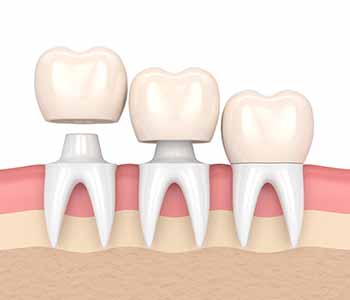Enjoy the beauty, health of personalized dental crowns treatment in Brampton, ON
Advanced dentistry allows Kensington Dental to rebuild teeth to health and beauty. Dr. Deepak Joshi and his skilled team replicate natural form and function by retaining as much tooth structure as possible. The more natural tooth structure retained, generally the less invasive the procedure. As it relates to crowns, a type of restoration known as a partial crown may be recommended to reconstruct a damaged tooth conservatively. While these conservative procedures certainly have their benefits, dental crowns treatment in Brampton ON at our office varies person to person. We take a long-term view of both cosmetic and restorative treatment. For maximum durability and lifelong health, a full-coverage crown may be most appropriate for your needs and to restore or maintain chewing function and a natural appearance.
The conservative approach
Partial crowns are more specifically called inlays and onlays. They are designed to build up the damaged portions of teeth. Prepared to your unique specifications, partial crowns at Kensington Dental are only made with the highest quality dental materials, which are seamlessly fitted and bonded to existing natural tooth structure.
Inlays fit inside of teeth, on the grooved area between the cusps. Onlays are larger, covering a bigger surface area. Like inlays, they fit within the grooved inner parts of teeth, but they also wrap up and around one or more of a tooth’s points. An onlay may be more appropriate, in the event that you have more extensive decay or damage. To properly rebuild the tooth for maximum durability, a restoration that spans the entire chewing area, plus at least one cusp, may be necessary. Both inlays and onlays effectively restore teeth, because advanced materials that mimic enamel are combined with techniques that bond each restoration to the natural, healthy structure underneath.
Schedule an Appointment today.
These partial-coverage crowns may be suitable alternatives to dental fillings. Sometimes, “filling in” a large cavity or otherwise substantial area of damage with dental materials can make a tooth vulnerable to greater decay over the longer term. A large filling can be more fragile to damage from the everyday stresses of chewing and biting, making it prone to cracks and breakage. Furthermore, these large or worn fillings may allow harmful bacteria and food debris to enter into the tooth, which can give rise to more decay, gum disease, and infection. Patients with greater needs for restoration may be better-served with onlays rather than inlays.
The full-coverage option

Full crowns fit over the entire tooth. Existing, healthy tooth structure must be reduced and prepared to make room for the crown. This type of restoration is also called a cap, because it’s designed to fit over the natural tooth like a cap fits snugly on your head. Since every patient we see is unique, Dr. Joshi and the team don’t limit your options for dental materials used to recreate your tooth. Gold, porcelain, and a mix of porcelain and metal can all be viable options. The best material for you depends on factors ranging from the visibility and function of the tooth to be treated, to your budget and personal preferences.
Crowns are also frequently associated with root canal therapy. A tooth must be in a healthy state before covering it with a dental crown. Root canal treatment resolves existing infections and positions you for long-term success with your new crown. Crowns don’t always follow root canal treatment. They may also be used to recontour a very poorly shaped tooth, and as a necessary component of either a dental bridge or dental implant-supported crown.
The process of getting a crown generally includes:
- Filing down the underlying tooth structure
- Using filling material to build up support (in cases where a large amount of tooth structure is gone)
- An impression is made
- The impression is sent to a lab, where a skilled ceramicist makes the new tooth
- A temporary crown is placed
- In about two weeks, return to the office
- The temporary is removed, and the crown’s fit and color is checked
- If all looks good, the crown is permanently cemented in place
Enjoy improved looks and oral health for 5 to 15 years or longer with proper care. We’ll work with you to determine the best option to meet your needs and goals. Contact us today.

